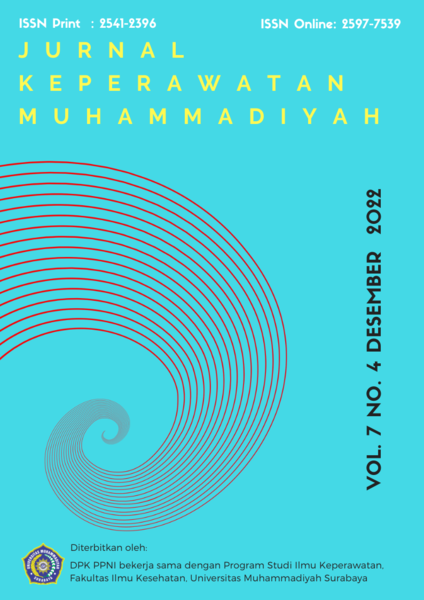Hubungan Kadar Hemoglobin (Hb) Dengan Derajat Diabetic Foot Ulcers (DFU) Di Kabupaten Bone
DOI:
https://doi.org/10.30651/jkm.v7i4.15085Keywords:
Diabetic Foot Ulcer, Hemoglobin, AnemiaAbstract
Objective: Vascular assessment, including the assessment of hemoglobin (Hb) levels or anemia, is a very important part of the treatment of Diabetic Foot Ulcers (DFU). However, several studies have shown different results regarding the relationship of Hemoglobin as a DFU wound healing factor.
This study was to determine the relationship between hemoglobin levels and the degree of Diabetic Foot Ulcers (DFU).
Methods: The design of this study was an analytic observational study in which the research subjects were Diabetic Foot Ulcers (DFU) patients undergoing treatment at a nurse's independent practice clinic in Bone Regency). The independent variable is hemoglobin level while the dependent variable is the degree of injury according to Meggitt Wagner's classification. The sampling technique used was the total sampling method.
Results: This study was conducted in the independent practice of nurses in Bone Regency and involved 30 samples that met the inclusion and exclusion criteria. Data on hemoglobin levels and severity of Diabetic Foot Ulcers (DFU) were obtained from direct observation. Furthermore, the data were analyzed descriptively and tested with Spearman correlation. Spearman correlation test results obtained p = 0.083 (p> 0.05) and r = -0.322.
Conclusion: there is a negative but not significant relationship between hemoglobin levels and the severity of diabetic ulcers with a weak correlation strength level. The lower the hemoglobin level, the more severe the severity of the ulcer.
References
Adane, T., & Getawa, S. (2021). Anaemia and its associated factors among diabetes mellitus patients in Ethiopia : A systematic review and meta-  analysis. February, 1–10. https://doi.org/10.1002/edm2.260
Asirvatham, A. R., Menon, U., Pavithran, P. V, Vasukutty, J. R., Kumar, H., Bhavani, N., Menon, A., & Nair, V. (2019). Role of Procalcitonin as a Predictor of Clinical Outcome in Acute Diabetic Foot Infections : A Prospective Study. Indian Journal of Endocrinology and Metabolism, 23(1), 122–127. https://doi.org/10.4103/ijem.IJEM
Chokkalingam, M., Packiaraj, G. D., & V, S. K. (2021). Original Research Article A Prospective Study of Assessment of Anemia and Hypoalbuminemia in a Diabetic Patients with Ulcers Conflict of Interest : Nil Source of support : Nil. 4(19), 246–247.
Dharma, K. K. (2011). Metodologi Penelitian Keperawatan. CV. Trans Info Media.
Ezeani, I. U., Ugwu, E. T., Adeleye, F. O., Gezawa, I. D., Okpe, I. O., & Enamino, M. I. (2020). Determinants of wound healing in patients hospitalized for diabetic foot ulcer: results from the MEDFUN study. Endocrine Regulations, 54(3), 207–216. https://doi.org/https://doi.org/10.2478/enr-2020-0023
Hariftyan, A. S., Novida, H., & Mouli Edward. (2021). Profile Of Diabetic Foot Ulcer Patients At Tertiary Care Hospital In Surabaya, Indonesia. 9(3), 293–302. https://doi.org/10.20473/jbe.v9i32021.293
Id, I. D. G., Ugwu, E. T., Ezeani, I., Adeleye, O., Okpe, I., & Enamino, M. (2019). Anemia in patients with diabetic foot ulcer and its impact on disease outcome among Nigerians : Results from the MEDFUN study. Journal P One, 180, 1–11.
Kementerian Kesehatan RI. (2018). Hasil Utama Riset Kesehatan Dasar. Kementrian Kesehatan Republik Indonesia, 1–100. http://www.depkes.go.id/resources/download/info-terkini/hasil-riskesdas-2018.pdf
Khanbhai, M., Wright, J., Hurel, S., & Richards, T. (2012). renal function , and the diabetic foot : What are the relationships ? 15(4).
Ry, K., Cl, L., Jk, R., Ortho, M. S., Mz, Z., Ortho, M. S., & Bc, L. (2019). Predictive Factors of Major Lower Extremity Amputations in Diabetic Foot Predictive Factors of Major Lower Extremity Amputations in Diabetic Foot Infections : A Cross-sectional Study at District Hospital in Malaysia. Malaysian Orthopaedic Journal, 13(3), 45–52. https://doi.org/10.5704/MOJ.1911.008
Saeedi, P., Petersohn, I., Salpea, P., Malanda, B., Karuranga, S., Unwin, N., Colagiuri, S., Guariguata, L., Motala, A. A., Ogurtsova, K., Shaw, J. E., Bright, D., & Williams, R. (2019). Global and regional diabetes prevalence estimates for 2019 and projections for 2030 and 2045: Results from the International Diabetes Federation Diabetes Atlas, 9th edition. Diabetes Research and Clinical Practice, 157, 107843. https://doi.org/10.1016/j.diabres.2019.107843
Shabhay, A., Horumpende, P., Shabhay, Z., Mganga, A., Baal, J. Van, & Msuya, D. (2021). Clinical profiles of diabetic foot ulcer patients undergoing major limb amputation at a tertiary care center in North ‑ eastern Tanzania. BMC Surgery, 21(34), 1–7. https://doi.org/10.1186/s12893-021-01051-3
Shareef, A. M., Ahmedani, M. Y., & Waris, N. (2019). Strong association of anemia in people with diabetic foot ulcers ( DFUs ): Study from a specialist foot care center. Pak J Med Sci, 35(5), 1216–1220.
Sugiyono. (2013). Metode Penelitian Pendidikan. Alfabeta.
Veer, B. (2014). Dasar - dasar Biostatistik (S. H. dan K. Achmad (ed.)). Kharisma Publishing Grup.
WHO. (2011). Haemoglobin concentrations for the diagnosis of anaemia and assessment of severity. 1–6.
Yammine, K., Hayek, F., & Assi, C. (2021). Is there an association between anemia and diabetic foot ulcers? A systematic review and meta-analysis. Wound repair and regeneration : official publication of the Wound Healing Society [and] the European Tissue Repair Society. 29(3), 432–442. https://doi.org/https://doi.org/10.1111/wrr.12902
Downloads
Published
Issue
Section
License
- Penulis tetap memegang hak atas karyanya dan memberikan hak publikasi pertama kepada jurnal ini yang secara simultan karya tersebut dilisensikan di bawah:Â Creative Commons Attribution-ShareAlike 4.0 International (CC BY-SA 4.0)













